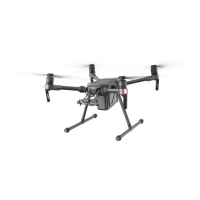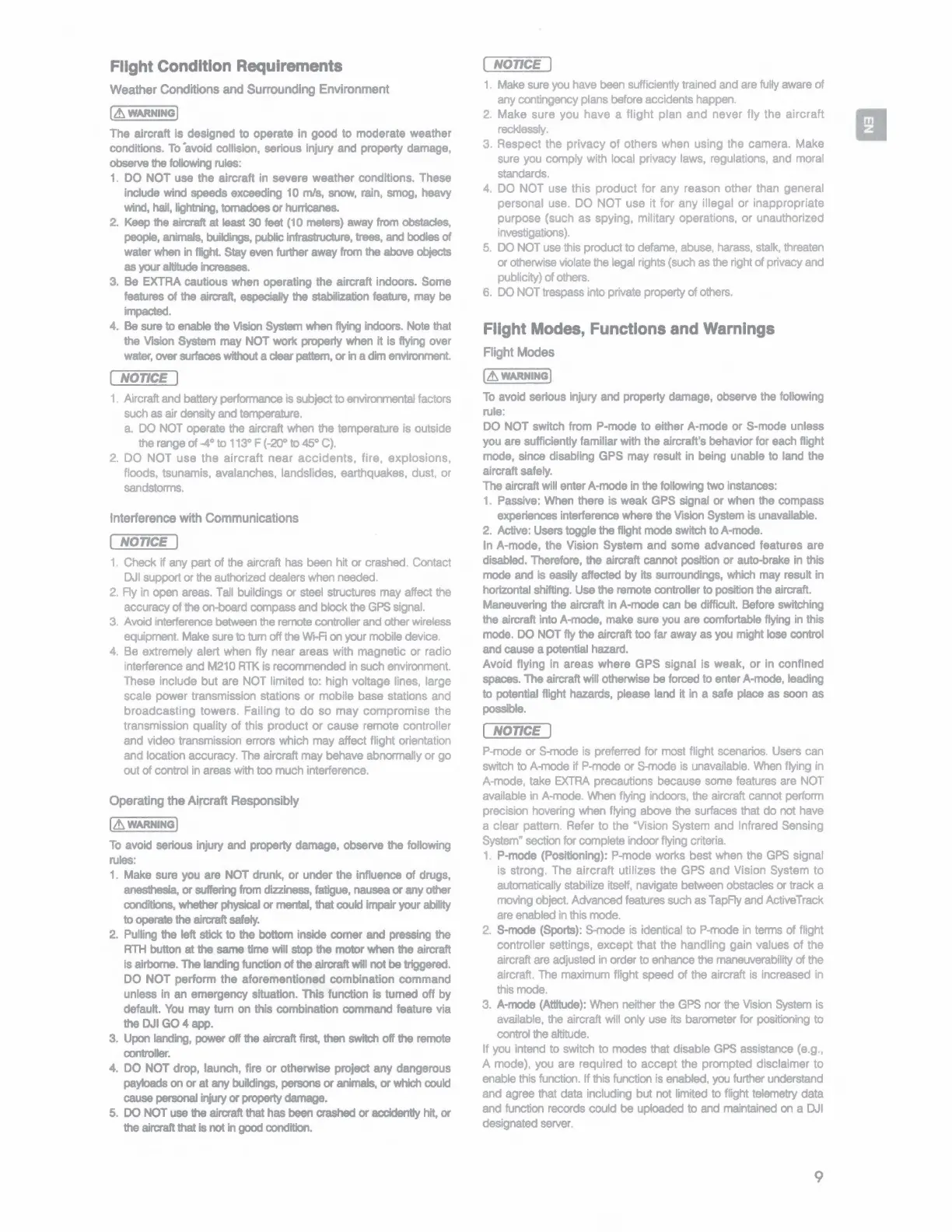Flight Condition Requirements
Weather
Conditions
and
Surrounding Environment
[~WARNING!
The
aircraft
Is
designed
to
operate
in
good
to
moderate
weather
conditions.
To
·avoid
collision, serious injury
and
property
damage,
observe
the
following
rules:
1.
DO
NOT
use
the
aircraft
in
severe
weather
conditions.
These
include
wind
speeds
exceeding
1 O mis,
snow,
rain,
smog,
heavy
wind,
hail,
lightning,
tornadoes
or
hurricanes.
2.
Keep
the
aircraft
at
least 30 feet (10
meters)
away
from
obstacles,
people,
animals,
buildings,
public
infrastructure,
trees,
and
bodies
of
water
when
in
flight.
Stay
even
further
away
from
the
above
objects
as
your
altitude
increases.
3.
Be
EXTRA
cautious
when
operating
the
aircraft
indoors.
Some
features
of
the
aircraft,
especially
the
stabilization
feature,
may
be
impacted.
4.
Be
sure
to
enable
the
Vision
System
when
flying
indoors.
Note
that
the
Vision
System
may
NOT
work
property
when
it
is
flying
over
water,
over
surfaces
without
a
clear
pattern,
or
in
a
dim
environment.
I NOTICE I
Aircraft
and
battery
performance
is
subject to
environmental
factors
such
as
air
density
and
temperature.
a.
DO
NOT
operate the aircraft
when
the temperature
is
outside
the
range
of
--4°
to
113°
F (-20°
to
45°
C).
2.
DO
NOT use the aircraft near accidents, fire, explosions,
floods, tsunamis, avalanches, landslides, earthquakes. dust,
or
sandstorms.
Interference with Communications
I NOTICE I
1 Check
if
any
part of
the
aircraft
has
been hit
or
crashed. Contact
DJI
support
or
the
authorized
dealers when needed.
2.
Fly
in
open
areas.
Tall
buildings
or
steel
structures
may
affect
the
accuracy of the on-board compass and block
the
GPS
signal.
3.
Avoid
interference
between
the
remote
controller
and
other
wireless
equipment.
Make
sure
to
tum
off
the
Wi-Fi
on
your
mobile
device.
4.
Be
extremely alert when fly near areas with magnetic
or
radio
interference
and
M210
RTK
is
recommended
in
such
environment.
These
include but
are
NOT
limited to: high voltage lines, large
scale power transmission stations or mobile base stations and
broadcasting towers. Failing to do so may compromise the
transmission quality of this product or cause remote controller
and video transmission errors which
may
affect flight orientation
and
location accuracy.
The
aircraft
may
behave abnormally or go
out
of control
in
areas
with
too much interference.
Operating
the Aircraft Responsibly
!~WARNING!
To
avoid
serious injury
and
property damage, observe the following
rules:
1.
Make
sure
you
are
NOT
drunk, or under the influence of drugs,
anesthesia,
or
suffering
from
dizziness,
fatigue,
nausea
or
any
other
conditions,
whether
physical
or
mental, that
could
impair your ability
to
operate
the
aircraft
safely.
2.
Pulling
the
left stick
to
the
bottom inside comer
and
pressing
the
RTH
button
at the
same
time
will stop
the
motor
when
the aircraft
is
airborne.
The
landing
function of
the
aircraft
will
not be
triggered.
DO
NOT perform the aforementioned combination command
unless
in
an
emergency situation. This function is turned off
by
default.
You
may tum
on
this combination command feature via
the
DJI
GO
4
app.
3.
Upon
landing,
power
off
the
aircraft
first,
then
switch
off
the
remote
controller.
4.
DO
NOT
drop, launch, fire or otherwise project any dangerous
payloads
on
or
at
any
buildings,
persons or
animals,
or
which
could
cause
personal injury
or
property damage.
5.
DO
NOT
use
the
aircraft that
has
been
crashed
or
accidently
hit,
or
the
aircraft
that
is
not
in
good
condition.
NOTICE
1
Make
sure
you
have
been
sufficiently trained
and
are
fully
aware
of
any
contingency plans
before
accidents
happen.
2.
Make sure you have a flight plan and never fly the aircraft
recklessly.
3. Respect the privacy of others when using the camera. Make
sure
you
comply with local privacy laws, regulations,
and
moral
standards.
4.
DO
NOT use this product for any reason other than general
personal use.
DO
NOT
use it for any illegal or inappropriate
purpose (such as spying, military operations, or unauthorized
investigations).
5.
DO
NOT
use
this
product
to
defame,
abuse,
harass,
stalk,
threaten
or
otherwise
violate
the
legal
rights
(such
as
the
right
of privacy
and
publicity) of
others.
6.
DO
NOT
trespass
into
private
property of
others.
Flight
Modes,
Functions
and
Warnings
Flight
Modes
[~WARNING!
To
avoid
serious injury
and
property
damage,
observe the following
rule:
DO
NOT switch from P-mode to either A-mode or S-mode unless
you
are
sufficiently familiar with the aircraft's behavior for
each
flight
mode, since disabling GPS
may
result
in
being unable
to
land the
aircraft
safely.
The
aircraft
will
enter
A-mode
in
the following two
instances:
1.
Passive:
When
there is weak
GPS
signal or
when
the compass
experiences
interference where
the
Vision
System
is
unavailable.
2.
Active:
Users
toggle
the
flight mode switch
to
A-mode.
In
A-mode, the Vision System and some advanced features are
disabled.
Therefore,
the
aircraft cannot position
or
auto-brake
in
this
mode
and
is easily affected
by
its
surroundings,
which
may
result
in
horizontal
shifting.
Use
the
remote
controller
to
position
the
aircraft.
Maneuvering
the
aircraft
in
A-mode
can
be
difficult.
Before
switching
the aircraft
into
A-mode,
make
sure
you
are
comfortable
flying
in
this
mode.
DO
NOT
fly the aircraft too far
away
as
you
might
lose
control
and
cause
a potential
hazard.
Avoid flying in areas where GPS signal is
weak,
or in confined
spaces.
The aircraft will otherwise be
forced
to
enter
A-mode,
leading
to potential flight hazards, please
land
it
in
a
safe
place
as
soon
as
possible.
I NOTICE I
P-mode
or
S-mode
is
preferred
for
most
flight
scenarios.
Users
can
switch
to
A-mode
if
P-mode
or
S-mode
is
unavailable.
When
flying
in
A-mode,
take
EXTRA
precautions because
some
features
are
NOT
available
in
A-mode.
\Nhen
flying
indoors,
the
aircraft
cannot
perform
precision hovering
when
flying above the surfaces that do not
have
a clear pattern. Refer to the "Vision System and Infrared Sensing
System"
section
for
complete indoor flying
criteria.
1
P-mode
(Positioning):
P-mode works best
when
the
GPS
signal
is
strong.
The
aircraft utilizes the
GPS
and Vision System to
automatically
stabilize
itsetf,
navigate
between
obstacles
or
track a
moving
object. Advanced
features
such
as
TapFly
and
ActiveTrack
are
enabled
in
this
mode.
2.
S-mode
(Sports):
S-mode
is
identical to
P-mode
in
terms
of flight
controller settings, except that the handling gain values of the
aircraft
are
adjusted
in
order
to
enhance
the
maneuverability
of
the
aircraft.
The
maximum
flight speed of the aircraft
is
increased
in
this
mode.
3.
A-mode
(Attitude):
When
neither
the
GPS
nor
the
Vision
System
is
available,
the
aircraft
will
only
use
its
barometer for positioning
to
control
the
altitude.
If
you
intend
to
switch
to
modes that disable
GPS
assistance
(e.g.,
A mode),
you
are
required to accept the prompted disclaimer
to
enable
this
function.
If
this
function
is
enabled,
you
further
understand
and
agree
that
data including but
not
limited
to
flight
telemetry
data
and
function
records could be uploaded
to
and
maintained
on
a
DJI
designated
server.
9
•

